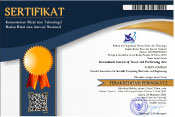(2) Hartono Hartono
(3) Deasylina da Ary
*corresponding author
AbstractEthno pedagogy examines the interaction of pedagogical and cultural traditions as well as social and pedagogical processes and examines educational methods and solutions used by the Lematang people in Lahat District. This study aims to analyze the application of Ethno pedagogy in learning erai-erai dance. Art-based qualitative methods with an ethnopedagogical approach as a data collection strategy based on observation, interviews and document research. Several stages of the interview activities included interview planning, conducting interviews, recording interview data and activities after the interview, namely checking the validity of the data and making systematic data so that it was ready to be used as material for further analysis. Source triangulation techniques to check data accuracy and test the credibility of data from various sources, then to compare the results of interviews between informants who are directly or indirectly involved. The results of this study are the dissemination of erai-erai dance performances through a socialization process so that ethnopedagogical practices emerge in the community with various learning strategies for erai-erai dance practised by each social class with their respective roles, thus directly or indirectly creating ethnopedagogical practices. Then, a conservation strategy involving ethnopedagogical practices in erai-erai dance is implemented using social media. The discussion above shows the contribution of research, although, on the other hand, this research has many weaknesses
KeywordsErai-Erai Dance Performances; Ethnopedagogical Practice; Learning Patterns; Conservation Strategy; Lematang Malay Community
|
DOIhttps://doi.org/10.31763/viperarts.v4i2.899 |
Article metrics10.31763/viperarts.v4i2.899 Abstract views : 1346 | PDF views : 574 |
Cite |
Full Text Download Download
|
References
[1] K. Zamyatin, “Indigenous peoples and education in the Russian Federation,†State of the World’s Indigenous Peoples. United Nations, pp. 187–206, 2017, doi: 10.18356/8e301ac2-en.
[2] I. Sandor, “Ethnopedagogy: The Term and Content,†Acta Educ. Gen., vol. 9, no. 3, pp. 105–117, Dec. 2019, doi: 10.2478/atd-2019-0016.
[3] T. Calamoneri, C. Dunagan, and N. McCarthy-Brown, “Ethical Dance Pedagogy: Bodies as Sites of Social Change,†J. Danc. Educ., vol. 20, no. 2, pp. 55–64, Apr. 2020, doi: 10.1080/15290824.2019.1566607.
[4] D. Risner, “Activities for Humanizing Dance Pedagogy: Immersive Learning in Practice,†J. Danc. Educ., vol. 21, no. 2, pp. 114–120, Apr. 2021, doi: 10.1080/15290824.2019.1678753.
[5] N. Rowe, X. Xiong, and H. Tuomeiciren, “Dancing from policy to pedagogy in China: Transgressions, surveillance and resistance from students, teachers and institutional leaders,†Policy Futur. Educ., vol. 18, no. 8, pp. 995–1010, Nov. 2020, doi: 10.1177/1478210320907802.
[6] P. H. Lawton, “At the Crossroads of Intersecting Ideologies: Community-Based Art Education, Community Engagement, and Social Practice Art,†Stud. Art Educ., vol. 60, no. 3, pp. 203–218, Jul. 2019, doi: 10.1080/00393541.2019.1639486.
[7] R. Weber and S. Reed, “Pedagogical Perspectives on Developing Creativity in Dance Students,†J. Danc. Educ., vol. 22, no. 2, pp. 119–128, Apr. 2022, doi: 10.1080/15290824.2020.1827147.
[8] M. P. Aninda and L. H. Sihombing, “The value of the Caci dance performance: changing the perspective of cultural violence on fighting dance performances in Manggarai Indonesia,†Int. J. Vis. Perform. Arts, vol. 4, no. 1, pp. 16–26, 2022, doi: 10.31763/viperarts.v4i1.595.
[9] S. Koc, “Values Lost in Society in the Eyes of Teachers,†J. Educ. Learn., vol. 11, no. 4, pp. 153–160, Jun. 2022, doi: 10.5539/jel.v11n4p153.
[10] J. H. Rolling, “A Paradigm Analysis of Arts-Based Research and Implications for Education,†Stud. Art Educ., vol. 51, no. 2, pp. 102–114, Jan. 2010, doi: 10.1080/00393541.2010.11518795.
[11] J. Adshead, V. A. Briginshaw, P. Hodgens, and M. R. Huxley, “A Chart of Skills and Concepts for Dance,†J. Aesthetic Educ., vol. 16, no. 3, pp. 49–61, Jan. 1982, doi: 10.2307/3332192.
[12] T. G. Sefton and K. Ricketts, “Carto-Elicitation: Improvised Performances/Narratives of Identity, Memory, and Sites of Fascination,†Learn. Landscapes, vol. 15, no. 1, pp. 323–336, Jun. 2022, doi: 10.36510/learnland.v15i1.1079.
[13] S. Hacicaferoglu, “The Role of Social Activities in Educational Institutions in the Socialization Process,†Educ. Q. Rev., vol. 5, no. 2, pp. 425–432, Jun. 2022, doi: 10.31014/aior.1993.05.02.502.
[14] S. Ehrenberg, “Choreographic practice and pedagogy as embodied ideological critique of the labour for knowledge,†Res. Danc. Educ., vol. 20, no. 2, pp. 97–112, May 2019, doi: 10.1080/14647893.2019.1591359.
[15] M. Giguere, “The Social Nature of Cognition in Dance: The Impact of Group Interaction on Dance Education Practices,†J. Danc. Educ., vol. 21, no. 3, pp. 132–139, Jul. 2021, doi: 10.1080/15290824.2021.1928676.
[16] L. R. L. Wilmot, “The Role of Teaching Artists in Postsecondary Education,†J. Danc. Educ., vol. 21, no. 1, pp. 24–33, Jan. 2021, doi: 10.1080/15290824.2019.1652756.
[17] S. Motevalli, N. Saffari, M. T. A. Michael, and F. H. Abadi, “Enculturation, Education and Sustainable Development: Understanding the Impact of Culture and Education on Climate Change,†Int. Educ. Stud., vol. 15, no. 4, pp. 31–41, Jul. 2022, doi: 10.5539/ies.v15n4p31.
[18] L. S. Kakimova, S. T. Balagazova, N. E. Mukeyeva, A. Z. Berdenova, and K. B. Azhgereyeva, “Pedagogical technologies for the emotional intelligence of a music teacher,†World J. Educ. Technol. Curr. Issues, vol. 14, no. 3, pp. 817–824, May 2022, doi: 10.18844/wjet.v14i3.7353.
[19] T. Berg, “Manifestations of surveillance in private sector dance education: the implicit challenges of integrating technology,†Res. Danc. Educ., vol. 21, no. 2, pp. 135–152, May 2020, doi: 10.1080/14647893.2020.1798393.
[20] E. E. Lobel, “A Model for Integrating Social and Creative Dance Forms in a Dance Education Course,†J. Danc. Educ., vol. 21, no. 1, pp. 44–47, Jan. 2021, doi: 10.1080/15290824.2020.1732984.
[21] R. I. Sadik, “A Promise of Practice: Community-Based Art Education in Pakistan,†Art Educ., vol. 74, no. 4, pp. 44–50, Jul. 2021, doi: 10.1080/00043125.2021.1905451.
[22] C. Liao and J. Devita, “Arts-Based Research in Precarious Pedagogy-Making Experiences,†Learn. Landscapes, vol. 15, no. 1, pp. 233–248, Jun. 2022, doi: 10.36510/learnland.v15i1.1073.
Refbacks
- There are currently no refbacks.
Copyright (c) 2022 Monika Artasia

This work is licensed under a Creative Commons Attribution-ShareAlike 4.0 International License.
___________________________________________________________
International Journal of Visual and Performing Arts
ISSN 2684-9259
Published by Association for Scientific Computing Electronics and Engineering (ASCEE)
W: http://pubs2.ascee.org/index.php/viperarts
E: sularso@ascee.org
Organized by:
 This work is licensed under a Creative Commons Attribution-ShareAlike 4.0
This work is licensed under a Creative Commons Attribution-ShareAlike 4.0
























